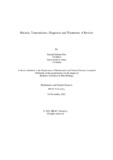| dc.contributor.advisor | Haque, Fahim Kabir Monjurul | |
| dc.contributor.author | Ritu, Sanjida Sultana | |
| dc.contributor.author | Dihan, Alaya Ferdous | |
| dc.date.accessioned | 2022-01-23T05:09:45Z | |
| dc.date.available | 2022-01-23T05:09:45Z | |
| dc.date.copyright | 2021 | |
| dc.date.issued | 2021-11 | |
| dc.identifier.other | ID 17126012 | |
| dc.identifier.other | ID 17126044 | |
| dc.identifier.uri | http://hdl.handle.net/10361/15965 | |
| dc.description | This thesis is submitted in partial fulfilment of the requirements for the degree of Bachelor of Science in Microbiology, 2021. | en_US |
| dc.description | Catalogued from PDF version of thesis. | |
| dc.description | Includes bibliographical references (pages 16-21). | |
| dc.description.abstract | Malaria is an ancient vector-borne human diseases that is caused by the plasmodium parasite. Anopheles mosquitoes are the vector that contains the plasmodium parasite sporozoites. There are 5 most common Plasmodium parasite species that can cause human infection. Those are Plasmodium vivax, Plasmodium ovale, Plasmodium malariae, Plasmodium falciparum, and Plasmodium knowlesi. In 2019, there were about 229 million cases of malaria worldwide. Africa is the most affected country of malaria. The spread and distribution of vector-borne diseases are greatly affected by environmental and climatic factors. Climatic factors especially temperature, humidity and rainfall, affect the ability of malaria parasites and Anopheles vectors to exist long enough to spread disease. An epidemic of malaria occurs when climate and other conditions suddenly favor the spread of malaria in areas where people have little or no immunity to malaria. In China, a sweet sagewort plant known as Qinghai (Latin Artemisia annua) was used to treat malaria as early as the 2nd century BC. Later, Different antimalarial drugs like quinolines, antifolates, and Artemisinin-combination therapies (ACTs) are used to treat malaria. Recently, The World Health Organization (WHO) recommends that children in Sub-Saharan Africa and other places with moderate to high P. falciparum malaria transmission get the RTS,S/AS01 (RTS,S) malaria vaccine. The proposal is based on the outcomes of a trial program that has served over 800,000 children in Ghana, Kenya, and Malawi since 2019. | en_US |
| dc.description.statementofresponsibility | Sanjida Sultana Ritu | |
| dc.description.statementofresponsibility | Alaya Ferdous Dihan | |
| dc.format.extent | 21 pages | |
| dc.language.iso | en | en_US |
| dc.publisher | Brac University | en_US |
| dc.rights | Brac University theses are protected by copyright. They may be viewed from this source for any purpose, but reproduction or distribution in any format is prohibited without written permission. | |
| dc.subject | Malaria | en_US |
| dc.subject | Anopheles | en_US |
| dc.subject | Plasmodium | en_US |
| dc.subject | Temperature | en_US |
| dc.subject | Transmission | en_US |
| dc.subject | Antimalarial drugs | en_US |
| dc.subject | Malaria vaccine | en_US |
| dc.subject.lcsh | Malaria--Chemotherapy | |
| dc.subject.lcsh | Malaria--Diagnosis | |
| dc.title | Malaria: transmission, diagnosis and treatment: A Review | en_US |
| dc.type | Thesis | en_US |
| dc.contributor.department | Department of Mathematics and Natural Sciences, Brac University | |
| dc.description.degree | B. Microbiology | |

